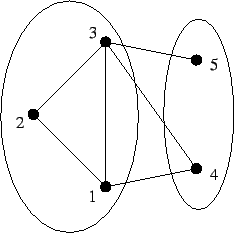
Zadanie Dwa przyjęcia (dwa)
Pomóż nam usprawnić bazę zadań!
Two Parties
Memory limit: 32 MB
King Byteasar has decided to throw two great parties and wants to invite to them every single Byteotian inhabitant. Of course he wants to invite each of them to exactly one of the parties. The king knows from his own vast experience that a person is having a good time when there is an even number of her/his friends at the party. Thus he has asked you to divide the country's inhabitants between two parties in a way that as many people as possible have an even number of friends at their party. A trivial division, i.e. one that leaves one party with no guests invited, is allowed. The acquaintanceship is a symmetric relation, i.e. whenever a person  knows the person
knows the person  , the person
, the person  also knows the person
also knows the person  .
.
Task
Write a programme that:
- reads from the standard input the number of Byteotia's inhabitants and the description of their acquaintances,
- splits the inhabitants into two parties in such way that the number of people who have an even number of friends at their party is as large as possible,
- writes to the standard output a list of people who should be invited to the first party.
Input
In the first line of the standard input there is one integer  (
( ) - it is the number of inhabitants of Byteotia. The inhabitants are numbered from
) - it is the number of inhabitants of Byteotia. The inhabitants are numbered from  to
to  . In the following
. In the following  lines there are the descriptions of subsequent persons' acquaintances. At the beginning of the
lines there are the descriptions of subsequent persons' acquaintances. At the beginning of the  'th line there is an integer
'th line there is an integer  (
( ) - the number of friends of the ith inhabitant. It is followed by
) - the number of friends of the ith inhabitant. It is followed by  pairwise distinct numbers of the
pairwise distinct numbers of the  'th inhabitant's friends. We assume that no inhabitant is her/his own friend. It follows that each acquaintance is written twice: if
'th inhabitant's friends. We assume that no inhabitant is her/his own friend. It follows that each acquaintance is written twice: if  and
and  know each other, then
know each other, then  appears on
appears on  's list of friends and
's list of friends and  appears on
appears on  's.
's.
Output
In the first line of the standard output your programme should write one integer  - the number of people who are to come to the first party. In the second line the
- the number of people who are to come to the first party. In the second line the  numbers of these people should be written. The rest shall come to the second party.
numbers of these people should be written. The rest shall come to the second party.
There are many correct divisions in this task - your programme should write any one of them.
Example
For the input data:
5 3 2 3 4 2 1 3 4 2 1 4 5 2 1 3 1 3
the correct result is:
3 1 2 3

In the above example everyone will have even number of friends at the party.
Task author: Wojciech Guzicki.
Kontakt
In the event of technical difficulties with Szkopuł, please contact us via email at [email protected].
If you would like to talk about tasks, solutions or technical problems, please visit our Discord servers. They are moderated by the community, but members of the support team are also active there.

 English
English